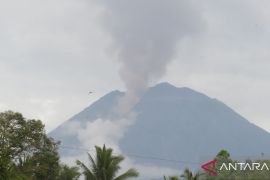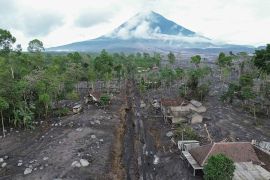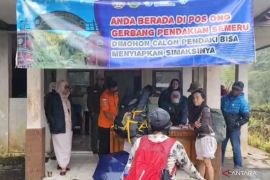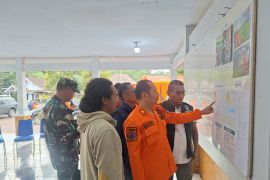East Java Police Spokesman Senior Commissioner Jules Abraham Abast said officers handed masks to drivers crossing the bridge, where ashfall reduced visibility and forced vehicles to slow down.
He said distribution focused on high-risk points along the southern route connecting the two districts, where ash accumulation was heaviest.
The measure aims to help residents continue activities safely as ash exposure can irritate eyes and disrupt breathing, Abast said.
East Java police deployed search and rescue personnel to support the public, including by providing masks to motorists traveling through ash-affected areas.
Authorities continue to monitor Semeru’s activity and coordinate with the Lumajang disaster agency and other local officials to assess risks.
Police urged residents to remain cautious, follow safety markers and use protective gear when outdoors, especially near areas impacted by the eruption.
Traffic in the affected zone remains manageable, though officers remain stationed along key routes to respond to possible increases in ash or weather changes linked to the eruption.
Beyond mask distribution, police set up a field kitchen run by Mobile Brigade personnel and Lumajang district police to supply food for evacuees in Pronojiwo.
Hundreds of ready-to-eat meals are delivered daily to residents staying in evacuation shelters after the latest eruption.
On Saturday night, Head of the Volcanology and Geological Disaster Migitation Agency (PVMBG) Priatin Hadi Wijaya said Semeru remains highly active and stays at Alert Level IV, Indonesia's highest warning.
Visual observations from Nov. 21–22, 2025, showed continuous eruptive activity, including white crater plumes rising 1,000 meters above the summit on Nov. 20.
Several eruptions produced ash columns 300–500 meters high drifting southeast, while lava-fall activity continued with runouts reaching 800 meters toward Besuk Kobokan.
He said ongoing lava falls and eruptions remain difficult to see due to weather, but seismic data indicates sustained volcanic activity.
Recorded quakes reflect continued subsurface magma supply and surface material release through eruptions and emissions, he said.
Two long-duration lahar tremors signaled flowing debris in Besuk Kobokan and triggered secondary explosions.
Related news: Most evacuees return home as Semeru activity stabilizes, BNPB says
Related news: Indonesia plans sustainable rebirth of Mount Semeru tourism
Translator: Zumrotun S, Rahmad Nasution
Editor: M Razi Rahman
Copyright © ANTARA 2025











